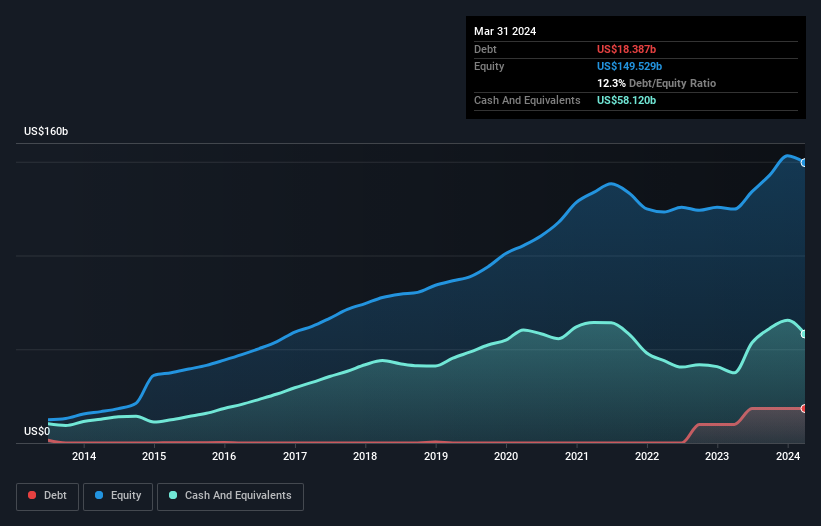These 4 Measures Indicate That Meta Platforms (NASDAQ:META) Is Using Debt Safely
Legendary fund manager Li Lu (who Charlie Munger backed) once said, 'The biggest investment risk is not the volatility of prices, but whether you will suffer a permanent loss of capital.' So it might be obvious that you need to consider debt, when you think about how risky any given stock is, because too much debt can sink a company. We can see that Meta Platforms, Inc. (NASDAQ:META) does use debt in its business. But the more important question is: how much risk is that debt creating?
Why Does Debt Bring Risk?
Debt and other liabilities become risky for a business when it cannot easily fulfill those obligations, either with free cash flow or by raising capital at an attractive price. Ultimately, if the company can't fulfill its legal obligations to repay debt, shareholders could walk away with nothing. While that is not too common, we often do see indebted companies permanently diluting shareholders because lenders force them to raise capital at a distressed price. Of course, plenty of companies use debt to fund growth, without any negative consequences. When we examine debt levels, we first consider both cash and debt levels, together.
See our latest analysis for Meta Platforms
How Much Debt Does Meta Platforms Carry?
You can click the graphic below for the historical numbers, but it shows that as of March 2024 Meta Platforms had US$18.4b of debt, an increase on US$9.93b, over one year. However, its balance sheet shows it holds US$58.1b in cash, so it actually has US$39.7b net cash.
How Healthy Is Meta Platforms' Balance Sheet?
Zooming in on the latest balance sheet data, we can see that Meta Platforms had liabilities of US$28.1b due within 12 months and liabilities of US$45.2b due beyond that. Offsetting these obligations, it had cash of US$58.1b as well as receivables valued at US$13.4b due within 12 months. So it has liabilities totalling US$1.77b more than its cash and near-term receivables, combined.
This state of affairs indicates that Meta Platforms' balance sheet looks quite solid, as its total liabilities are just about equal to its liquid assets. So while it's hard to imagine that the US$1.25t company is struggling for cash, we still think it's worth monitoring its balance sheet. While it does have liabilities worth noting, Meta Platforms also has more cash than debt, so we're pretty confident it can manage its debt safely.
On top of that, Meta Platforms grew its EBIT by 72% over the last twelve months, and that growth will make it easier to handle its debt. The balance sheet is clearly the area to focus on when you are analysing debt. But it is future earnings, more than anything, that will determine Meta Platforms's ability to maintain a healthy balance sheet going forward. So if you're focused on the future you can check out this free report showing analyst profit forecasts.
Finally, a business needs free cash flow to pay off debt; accounting profits just don't cut it. While Meta Platforms has net cash on its balance sheet, it's still worth taking a look at its ability to convert earnings before interest and tax (EBIT) to free cash flow, to help us understand how quickly it is building (or eroding) that cash balance. During the last three years, Meta Platforms generated free cash flow amounting to a very robust 80% of its EBIT, more than we'd expect. That positions it well to pay down debt if desirable to do so.
Summing Up
While it is always sensible to look at a company's total liabilities, it is very reassuring that Meta Platforms has US$39.7b in net cash. And it impressed us with free cash flow of US$50b, being 80% of its EBIT. So is Meta Platforms's debt a risk? It doesn't seem so to us. There's no doubt that we learn most about debt from the balance sheet. But ultimately, every company can contain risks that exist outside of the balance sheet. These risks can be hard to spot. Every company has them, and we've spotted 1 warning sign for Meta Platforms you should know about.
When all is said and done, sometimes its easier to focus on companies that don't even need debt. Readers can access a list of growth stocks with zero net debt 100% free, right now.
Have feedback on this article? Concerned about the content? Get in touch with us directly. Alternatively, email editorial-team (at) simplywallst.com.
This article by Simply Wall St is general in nature. We provide commentary based on historical data and analyst forecasts only using an unbiased methodology and our articles are not intended to be financial advice. It does not constitute a recommendation to buy or sell any stock, and does not take account of your objectives, or your financial situation. We aim to bring you long-term focused analysis driven by fundamental data. Note that our analysis may not factor in the latest price-sensitive company announcements or qualitative material. Simply Wall St has no position in any stocks mentioned.

 Yahoo Finance
Yahoo Finance 
